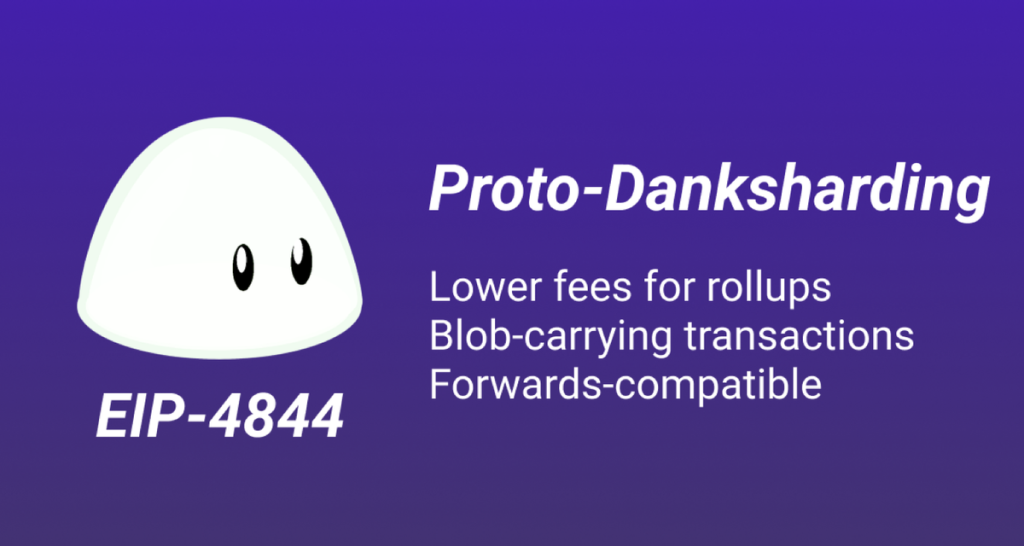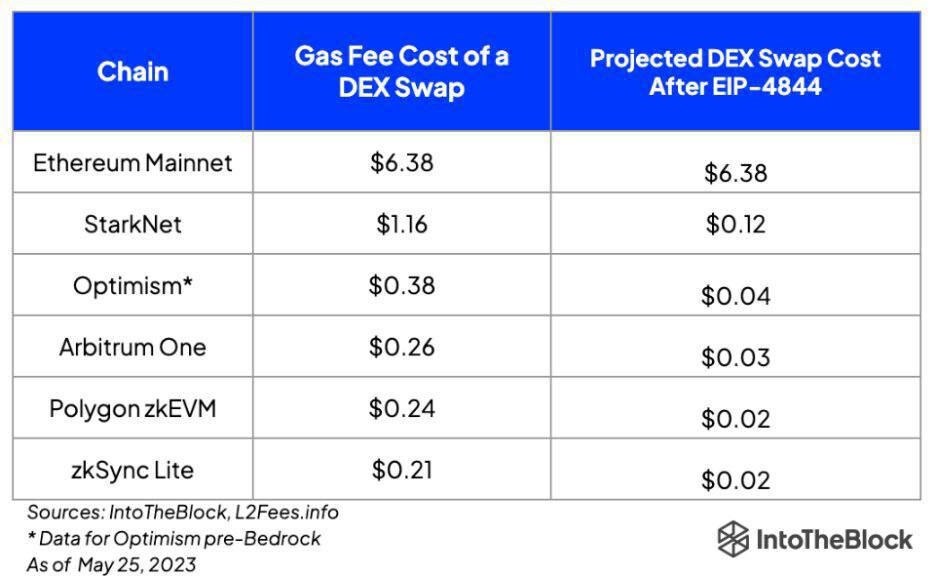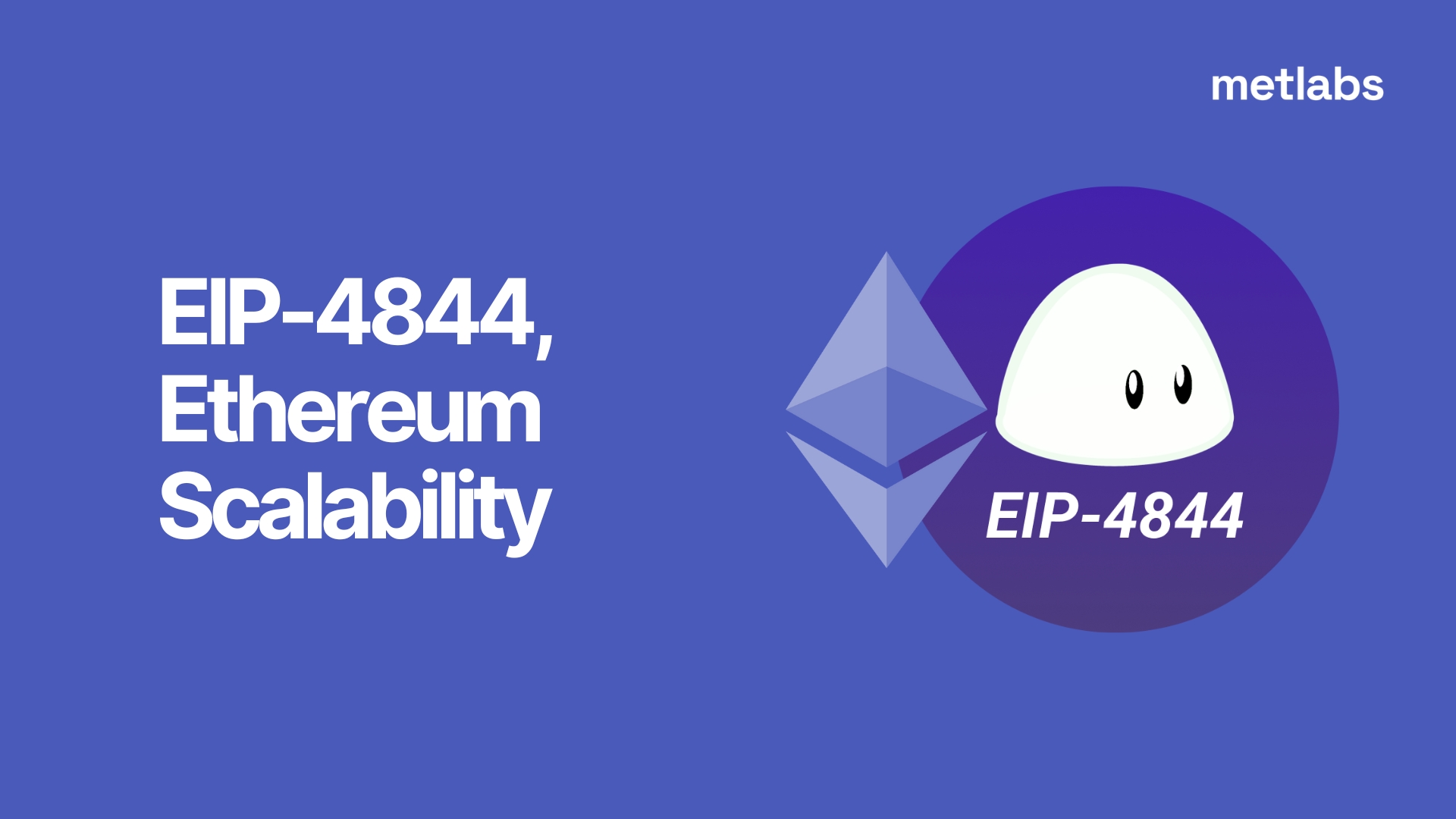It is widely recognized that Ethereum faces significant scalability challenges. Ever since Vitalik Buterin introduced the concept of the Trilemma, it has been a central topic of debate in the blockchain community. In response to this issue, EIP-4844 emerges as a proposal aimed at addressing the scalability obstacles that the Ethereum network faces.
Ethereum: A Brief Historical Journey
Ethereum has established itself as one of the most influential and revolutionary blockchain platforms since its launch in 2015. Created by Vitalik Buterin and other co-founders, Ethereum introduced the concept of smart contracts, programs that run on the blockchain and enable the creation of decentralized applications (dApps). This innovation has opened up a range of possibilities, from decentralized finance (DeFi) to blockchain games and digital collectibles (NFTs).
As Ethereum has grown in popularity, it has also faced significant challenges, especially in terms of scalability. Scalability refers to the network’s ability to handle an increasing number of transactions efficiently. In its early days, Ethereum could process around 15 transactions per second (tps), a figure insufficient to sustain its growing adoption and the demands of dApps.
Limitations in scalability have led to various issues, such as rising gas fees (the cost of conducting transactions and executing smart contracts on Ethereum) and slower confirmation times during periods of high demand. These issues not only affect the user experience but also limit Ethereum’s potential to serve large-scale applications.
The Importance of Sharding and Fee Optimization
To address these challenges, the Ethereum community has been working on a series of upgrades and improvement proposals. One key strategy for improving scalability is sharding, which divides the network into multiple fragments (shards) that can process transactions and smart contracts in parallel, significantly increasing the number of tps the network can handle.
Furthermore, various improvements have been proposed and implemented to optimize gas fees and enhance network efficiency, such as EIP-1559, which introduced a more predictable gas fee mechanism and burned a portion of the gas used in transactions, reducing the total ETH issuance.
In this context, EIP-4844 emerges, an improvement proposal that promises to take Ethereum’s scalability to a new level by introducing “blobs” of data, which allow for including a larger amount of data in transactions at a lower cost. This advancement is a crucial step towards full sharding implementation and represents a significant effort to overcome Ethereum’s scalability challenges, ensuring its long-term viability as infrastructure for global decentralized applications.
What is EIP-4844?
EIP-4844, informally known as “Proto-Danksharding,” is an Ethereum Improvement Proposal aimed at addressing one of the network’s most critical challenges: scalability. Designed to optimize network efficiency and significantly reduce gas fees for transactions and decentralized applications (dApps), this proposal introduces a new type of transaction that includes “blobs” of data. These blobs allow for the inclusion of large amounts of off-chain data in transactions more economically, without compromising the security or decentralization of the network.
Context and Purpose of the Proposal
Since its inception, Ethereum has experienced exponential growth, not only in terms of value and adoption but also in the diversity and complexity of applications built on its platform. However, this success has been accompanied by significant challenges, especially related to the network’s ability to process transactions efficiently and affordably. Before EIP-4844, proposed solutions focused on incremental improvements and the future implementation of sharding as a long-term solution. EIP-4844 emerges as an intermediate step toward sharding, seeking to alleviate the network’s current limitations while laying the groundwork for more radical solutions.
Main Innovations and Features
The central innovation of EIP-4844 is the introduction of the aforementioned “blobs” of data, which are essentially packages of raw data that can be attached to transactions on the Ethereum network. Unlike traditional data stored directly on the blockchain, blobs are designed to be stored off-chain, or outside the main chain, though they remain accessible and verifiable by the network.
This key feature allows data blobs to offer an intermediate solution between fully on-chain data storage, which is secure but costly and limited in capacity, and entirely off-chain solutions, which may be cheaper and more scalable but less secure and harder to verify. Data blobs, therefore, strike a balance between security, cost, and capacity, enabling developers to include large amounts of data in their dApps without overburdening the network or incurring high gas costs.
Impact on Network Efficiency
EIP-4844 and its implementation of data blobs have the potential to significantly transform the efficiency of the Ethereum network. By allowing large volumes of data to be processed and stored more economically, pressure on the main chain is reduced. This has a direct impact on network scalability, allowing for more transactions to be processed per second without compromising the integrity or security of the blockchain.
Additionally, by reducing the amount of data each node needs to store and process directly, EIP-4844 can contribute to lowering the hardware requirements for operating an Ethereum node, facilitating greater participation and helping to preserve the network’s decentralization.
Benefits for Developers and Users
For developers of decentralized applications (dApps), EIP-4844 opens up new possibilities for creating and operating applications that require handling large amounts of data, such as blockchain games, NFT markets, and DeFi platforms. The ability to include data blobs at a reduced cost allows developers to design richer and more complex user experiences without worrying about scalability limitations and prohibitive gas fees.
For end-users, this translates to a smoother and more accessible experience, with shorter wait times and lower costs when interacting with dApps on the Ethereum network. By reducing economic and technical barriers to using dApps, EIP-4844 has the potential to foster greater adoption and development of decentralized applications, contributing to the growth and diversification of the Ethereum ecosystem.
Proto-Danksharding
The term “Proto-Danksharding” is a colloquial name for EIP-4844, which encapsulates the goal of this proposal to be a precursor or initial phase towards the full implementation of “Danksharding.” Danksharding is a future scalability proposal for Ethereum that aims to partition the blockchain into multiple fragments (or “shards”), each of which would process transactions and store data in parallel, significantly increasing the total network capacity. The prefix “Proto” indicates that EIP-4844 introduces key concepts and technologies that will be foundational to Danksharding, albeit in a simplified and easier-to-implement form in the short term.

Differences and Similarities with Full Sharding
Unlike full sharding, which involves significant restructuring of the Ethereum blockchain to enable multiple parallel chains, Proto-Danksharding with EIP-4844 focuses on introducing a specific and manageable improvement to the current network structure. This improvement is the inclusion of data blobs, which, as mentioned earlier, allows for handling large amounts of data more efficiently without the need to completely reorganize Ethereum’s architecture.
Although Proto-Danksharding does not divide the network into shards, it lays the groundwork for this future evolution by demonstrating how large volumes of data can be efficiently handled and verified on the blockchain. In doing so, it lays the technological and conceptual foundations for Danksharding, ensuring that the Ethereum community and infrastructure are ready for this change when the time comes.
Implications for Ethereum Scalability
The implementation of Proto-Danksharding via EIP-4844 has significant implications for Ethereum’s scalability. By reducing costs and increasing the efficiency of data storage, this proposal allows the network to handle a much larger volume of transactions without incurring a proportional increase in gas fees. This is especially relevant for applications that require the exchange or storage of large amounts of data, such as non-fungible token (NFT) markets, blockchain-based games, and decentralized finance (DeFi) platforms.
By improving the network’s ability to handle data and transactions, Proto-Danksharding contributes to a more immediate and practical solution to Ethereum’s scalability challenges, while paving the way for more ambitious sharding implementations in the future. This incremental strategy allows Ethereum to evolve more smoothly and less disruptively, ensuring the stability and security of the network while introducing new technology.
In conclusion, Proto-Danksharding represents a crucial intermediate step towards the long-term vision of a highly scalable and efficient Ethereum. By introducing fundamental technologies and concepts for the network’s future sharding, EIP-4844 not only addresses the immediate scalability needs but also prepares Ethereum for its next major evolution, maintaining its position as one of the most advanced and widely used blockchain platforms in the world.
EIP-4844 and Gas Fee Reduction
One of the most significant promises of EIP-4844 is its ability to reduce gas fees on the Ethereum network, a critical issue that has affected both users and developers. This point examines how EIP-4844 aims to address this issue, comparing costs before and after its implementation and providing practical examples of transaction savings.
Gas fees are a central concern for the Ethereum community, varying dramatically with network congestion. During periods of high demand, fees can increase substantially, affecting the viability of transactions and projects on the network. EIP-4844 seeks to mitigate this issue by introducing “blobs” of data, which allow for incorporating large volumes of data into transactions at a much lower gas cost compared to the current fee structure.
By moving towards a system where data can be processed and stored more efficiently, the network can handle a greater number of transactions without a proportional increase in gas fees. This is possible because data blobs reduce the amount of data that needs to be processed directly by the main chain, thus alleviating congestion and decreasing demand on network resources.
Cost Comparison Before and After EIP-4844
Before EIP-4844, data storage on the main chain is costly, both in terms of space and computation. For example, deploying a smart contract or conducting a transaction requiring a significant amount of data could incur prohibitive costs for developers and end-users. With the implementation of EIP-4844, these costs would be significantly reduced thanks to the ability to attach data blobs to transactions for a fraction of the cost.
To illustrate, a transaction that previously might have cost tens or even hundreds of dollars in gas fees, especially during periods of high demand, could see its cost reduced to a significant percentage of that amount. This reduction makes interacting with smart contracts and executing transactions on Ethereum more accessible and practical for a greater number of users.

Practical Examples of Transaction Savings
Consider the case of a blockchain-based game that needs to store state information for thousands of players. Before EIP-4844, each state update could require individual transactions with high gas costs, making it economically unfeasible. With EIP-4844, this data could be consolidated into blobs, drastically reducing transaction costs and enabling a smooth and cost-effective gaming experience.
Another practical example is that of DeFi platforms, which often require interaction with multiple smart contracts to execute a single operation. With the introduction of data blobs, the efficiency of these interactions could increase, reducing operational costs and facilitating more complex transactions at a lower cost.
Implementation and Development of EIP-4844
Implementing an improvement proposal like EIP-4844 on a network as large and complex as Ethereum is a process that involves multiple phases, from initial design and testing to community acceptance and eventual activation on the main network. This segment explores the current status of the proposal, the technical challenges it presents, and the roadmap towards its implementation.
Current Status of the Proposal
EIP-4844 has gone through several stages of development, starting with its conceptualization and initial drafting. As is customary in the evolution process of Ethereum, the proposal undergoes rigorous scrutiny and discussion within the community, including developers, researchers, and end-users. These discussions are crucial for refining the proposal, ensuring that it effectively addresses the scalability challenges of the network without compromising its security or decentralization.
As of the date of the last update, EIP-4844 is in a phase of review and testing, with test implementations on various Ethereum testnets. These test networks allow developers and the community to experiment with the new functionalities and assess their impact in different scenarios without affecting the main network.
Roadmap and Important Dates
The path to the full implementation of EIP-4844 on the Ethereum main network is outlined in a roadmap that includes several phases. After the initial phases of design and discussion, the proposal undergoes extensive testing on test networks. These tests are crucial for identifying and addressing any issues before considering implementation on the main network.
The exact dates for the implementation of EIP-4844 depend on the results of these tests and the general acceptance of the proposal by the Ethereum community. However, the goal is to move towards its activation in one of the future network updates, known as hard forks, after ensuring that the proposal is robust and has the necessary support.
Comparison with Other Improvement Proposals: EIP-1559 VS EIP-4844
EIP-4844 is just one of many improvement proposals designed to address the scalability and efficiency challenges on the Ethereum network. To better understand the context and importance of EIP-4844, it’s useful to compare it with other significant proposals, such as EIP-1559 and other relevant developments in the ecosystem. This comparison highlights synergies, differences, and how EIP-4844 complements other enhancements to advance towards a more scalable and efficient Ethereum.
- EIP-1559, implemented as part of the London upgrade in August 2021, introduced a more predictable gas fee mechanism and ETH burning that reduces total ETH issuance. While EIP-1559 has been instrumental in improving Ethereum’s gas economy, its main focus is optimizing the fee system and not necessarily increasing the network’s transaction processing capacity.
- EIP-4844, on the other hand, specifically focuses on improving scalability by introducing data blobs to enable transactions with large volumes of data at a reduced cost. While both EIPs address aspects of gas fees, EIP-4844 has a more direct impact on the network’s ability to handle a greater number of transactions and data, complementing EIP-1559’s fee management improvements.
EIP-4844 does not exist in isolation; it is part of a broader set of planned improvements for the Ethereum network, including the transition to Ethereum 2.0 with the introduction of proof of stake (PoS) consensus, sharding, and other scalability and security optimizations.
- Proof of Stake (PoS) Consensus: The transition to PoS, completed with the merge, has paved the way for future scalability improvements by making the network more energy-efficient and secure. EIP-4844 complements this transition by directly addressing transaction scalability.
- Sharding: A planned future upgrade for Ethereum, which will partition the network into multiple fragments capable of processing transactions and smart contracts in parallel. EIP-4844 is considered a step towards full sharding, introducing concepts like data blobs that will help alleviate network strain before sharding implementation.
FAQs about EIP-4844
What is EIP-4844?
EIP-4844, also known as “Proto-Danksharding,” is an improvement proposal for the Ethereum network that introduces “data blobs.” These blobs allow for efficient off-chain storage of large amounts of data, reducing gas fees and improving network scalability.
How does EIP-4844 work?
It works by allowing the inclusion of data blobs in transactions at a reduced gas cost. These blobs are designed to store large volumes of data more economically, without being executable, thereby relieving the burden on the main chain and improving network efficiency.
What problems does EIP-4844 seek to solve?
EIP-4844 aims to address two main issues with Ethereum: high gas fees and scalability limitations. By allowing a more efficient way to handle large amounts of data, it facilitates cheaper operations and greater transaction processing capacity for the network.
What are the benefits of EIP-4844?
The benefits include reduced gas fees for transactions involving large amounts of data, increased scalability for the Ethereum network, and enabling new applications and uses for dApps by allowing them to handle data more efficiently.
How does EIP-4844 affect dApp developers?
Positively, by reducing the costs associated with data storage and handling. This allows developers to create more complex and data-rich applications without worrying about scalability limitations and high gas costs.
Is EIP-4844 already implemented?
As of the last update, EIP-4844 was in the process of review and testing on test networks. Its final implementation depends on the results of these tests and the approval of the Ethereum community.
How does EIP-4844 relate to sharding?
EIP-4844 is a step towards the full implementation of sharding on Ethereum. It introduces concepts like data blobs, which are expected to play a crucial role in the future shard architecture of the network, improving scalability and data handling.
What impact will EIP-4844 have on gas fees in the long term?
It is expected to significantly reduce gas fees for transactions involving large volumes of data, although the exact impact depends on how developers and users adopt and utilize the new capabilities introduced by the EIP.



